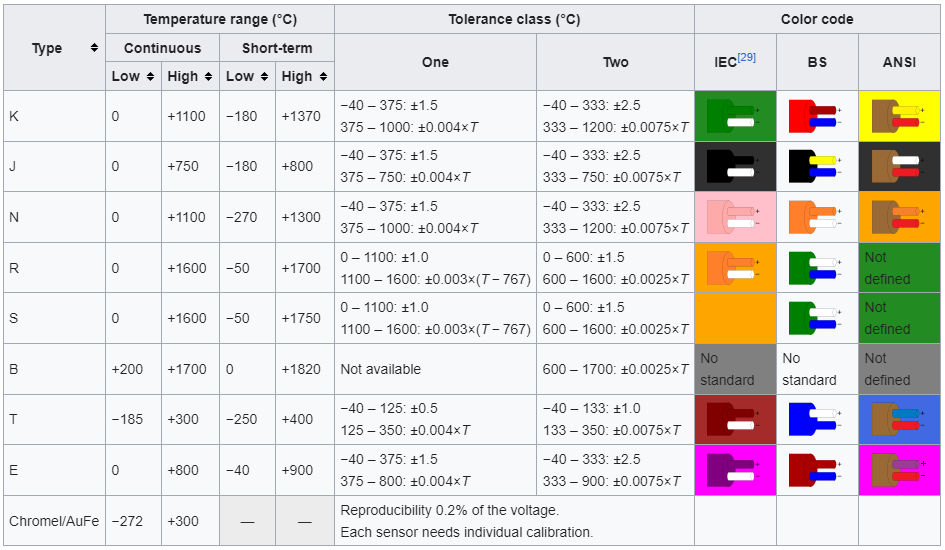Selecting the Right Hardware
The goal of this section is to help you decide what thermocouple and LabJack pairing you will need for your application. We will walk you through the decision-making process!
Thermocouple Hardware Recommendations
Primary considerations when selecting a thermocouple should be:
Type
Limits of Error
Junction Type
Type and Limits of Error
The thermocouple type might be selected based on your measurement range, measurement media, and the sensor cost. Type K thermocouples are commonly used due to their low cost and wide measurement range.
Thermocouples are commonly designated as having either standard or special limits of error where the special limits of error sensors have tighter accuracy tolerances.
The following table has additional information to consider about different thermocouple types and limits of error. Tolerance class 1 in the table is sometimes described as having special limits of error when ordering. Also see the types section further up the page:

Source: https://en.wikipedia.org/wiki/Thermocouple#Comparison_of_types
Junction Type

Source: https://www.omega.com/en-us/resources/selecting-a-thermocouple
Thermocouples are available with the hot junction grounded, exposed, or ungrounded in probes. They can also be purchased as bare wire.
Grounded probes have the hot junction grounded to the probe. Exposed probes have the hot junction exposed outside of the probe. These probe choices and bare wire can provide better response times, but could be more prone to noise issues such as ground loops (see the complications section below).
Ungrounded probes have the hot junction disconnected from the probe, which worsens response time, but can help avoid noise issues.
For most users, we recommend the K-Type thermocouple, which works great from -100 to 1300 °C
If you are only measuring between -50 and 150 °C, consider using a silicon temperature sensor instead, like the EI-1034.
LabJack Hardware Recommendations
Highest Quality: T8
The T8 benefits from 8 channel-to-channel isolated analog inputs with 24-bit sigma-delta ADCs. Isolated inputs help tremendously to avoid complications such as ground loops.
It also supports the AIN_EF system, which can be used to perform automatic temperature conversion for a variety of probes.
Multiple T8s can be used to handle >8 thermocouples.
See the T8 Thermocouple Tutorial.
Minimum Cost: T4 + LJTick-InAmp (alt. U3)
The U3 or T4 with LJTick-InAmps are the least expensive way to get decent readings from thermocouples, but would provide lower resolution than the T8, T7, or U6 devices.
Cheapest option for 1-3 thermocouples. (After buying a few InAmps the U6 becomes a cheaper option)
See the U3/T4 Thermocouple Tutorial.
Many Channels: T7 (alt. U6) + CB37 Breakout
The 16-bit converter on the T7 is higher resolution than the T4, and the T7 also offers more channels on the base unit.
Using the CB37 accessory you can connect up to 14 thermocouples.
It also supports the AIN_EF system, which can be used to perform automatic temperature conversion for a variety of probes.
If resolution is important, the T7-Pro and U6-Pro provide a higher, 24-bit resolution. Perhaps more importantly, they also provide outstanding noise rejection. In particular, at lower sample rates the sigma-delta converters reject 50 and 60 Hz noise, which is a common problem with thermocouple signals.
Best option for low cost, many signals (4-14 thermocouples).
See the T7 Thermocouple Tutorial.
Most Channels: Mux80
If the 13 single-ended thermocouples supported by the T7/Pro or U6/Pro paired with the CB37 breakout is not enough, LabJack also provides the Mux80, which allows a T7/U6 to measure up to 26 differentially-connected thermocouples.
Lowest cost option for many signals (>14 thermocouples).
Up to 41 differential connections are possible with cross-connector wiring, but this is often not convenient.
We have found that making ground loop mistakes on the the Mux80 is very common. To minimize these problems we suggest always using differential thermocouple readings with the Mux80.
Device Comparison Table
Device | Ease-of-Use | Cost (More ⭐ is Cheaper) | Speed | Resolution | Max Number of TCs |
|---|---|---|---|---|---|
T8 | ⭐⭐⭐⭐ | ⭐ | ⭐⭐⭐⭐ | ⭐⭐⭐⭐ | 8 |
T7-Pro + CB37 | ⭐⭐⭐ | ⭐⭐ | ⭐ | ⭐⭐⭐ | 14 |
T7 + CB37 | ⭐⭐⭐ | ⭐⭐⭐ | ⭐⭐ | ⭐⭐ | 14 |
T4 + InAmp | ⭐⭐ | ⭐⭐⭐⭐ | ⭐⭐⭐ | ⭐ | 3 |
T7 + Mux80 | ⭐ | ⭐⭐⭐ | ⭐⭐ | ⭐⭐ | 26 |
